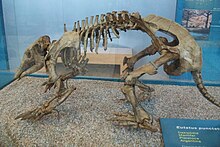| Eutatus Temporal range: Early Miocene-Late Pleistocene (Santacrucian-Lujanian) ~17.5–0.012 Ma PreꞒ Ꞓ O S D C P T J K Pg N | |
|---|---|

| |
| Eutatus punctatus skeleton | |

| |
| Eutatus punctatus armour | |
| Scientific classification | |
| Domain: | Eukaryota |
| Kingdom: | Animalia |
| Phylum: | Chordata |
| Class: | Mammalia |
| Order: | Cingulata |
| Family: | Chlamyphoridae |
| Genus: | †Eutatus Gervais 1867 |
| Species | |
Eutatus is an extinct genus of large armadillos of the family Chlamyphoridae. It was endemic to South America from the Early Miocene to Late Pleistocene, living from 17.5 Ma-11,000 years ago, with possible survival into the early Holocene (~ 7,500 BP) and existing for approximately 17.49 million years. Based on carbon isotope ratios, it is thought to have been an herbivore that fed on grasses.
Taxonomy
Eutatus was named by Gervais (1867). The type species is E. seguini. It was assigned to Dasypodidae by Carroll (1988).
Fossil distribution
The fossil remains are confined to Argentina and have been found in the Santacrucian Santa Cruz Formation, Ensenadan Miramar Formation, and the Lujanian Luján Formation.
Gallery
References
- ^ Eutatus at Fossilworks.org
- ^ Prado, J. L.; Martinez-Maza, C.; Alberdi, M. T. (2015). "Megafauna extinction in South America: A new chronology for the Argentine Pampas". Palaeogeography, Palaeoclimatology, Palaeoecology. 425: 41–49. Bibcode:2015PPP...425...41P. doi:10.1016/j.palaeo.2015.02.026.
- R. L. Carroll. 1988. Vertebrate Paleontology and Evolution. W.H. Freeman and Company
- Coy Inlet at Fossilworks.org
- Punta Hermengo at Fossilworks.org
- Paso Otero-Pardo at Fossilworks.org
| Taxon identifiers | |
|---|---|
| Eutatus | |




